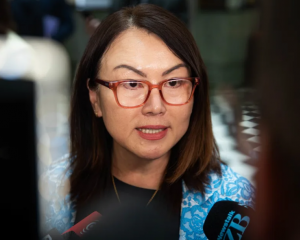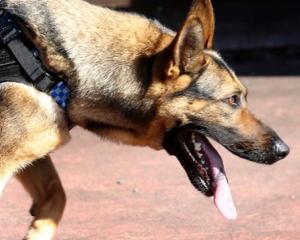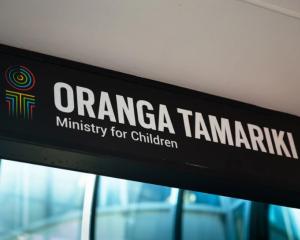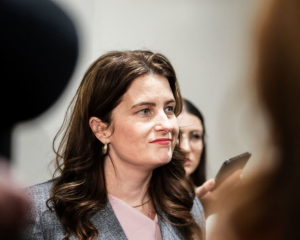
On a cold, wet, winter night in the tiny settlement of Kaitangata, South Otago, Dormer was seriously sick. A diabetic, she had chronic heart and lung disorders. She had chest pains and difficulty breathing and her temperature and oxygen level had sunk low.
At the door of her house she had to disconnect her home-oxygen machine to make the trip to the ambulance on the street and no portable oxygen bottle was provided.
As the 81kg Dormer was strapped into a chair with small wheels, she said to her daughter: "Sherrill, I'm going to die."
Sherrill Clayton-Reed, and the ambulance officer struggled to move the chair across the grass and it tipped over. The officer righted it and the pair tried to manhandle Dormer into the ambulance, but she collapsed, unconscious, taking the officer to the ground with her.
The officer yanked on his patient's pyjama pants but they ripped. Dormer was strapped back into the chair and lifted into the ambulance, put on a stretcher and given oxygen.
The officer considered seeking additional help on this, his second call of the night to Dormer's house, but decided it was more important to get her to hospital; he judged that if the local fire brigade turned out, it would delay him by at least eight minutes.
He assessed Dormer and sped to the hospital/medical centre around 13km away in Balclutha, with Clayton-Reed in the back.
Dormer died in the ambulance.
That was in June 2013. Today, 53-year-old Clayton-Reed, a grandmother, is still receiving grief counselling and suffering frightening flashbacks. She believes questions over her mother's care haven't been properly answered, despite investigations by the St John ambulance service and Deputy Health and Disability Commissioner (HDC) Theo Baker.
She can't fathom why her mother wasn't taken to hospital after her first ambulance call-out of the night, around 2am, when the ambulance officer was accompanied by a volunteer.
Baker's report points to a miscommunication between the Balclutha clinic doctor, who did not refuse admission but did so in a way that was interpreted as a refusal by the ambulance officer.
The tragic events have shone a light on the single-crewing of ambulances, a practice St John says is unsafe and should be abolished, but is unfortunately unavoidable in some cases because of a shortage of funding and staff.
St John's single-crewing rate overall has declined from 14 per cent of emergency responses in 2008-09, to around 10 per cent in 2014-15. However, it is more common in rural areas.
In Dormer's case single-crewing may have been avoidable, although this is contested. The ambulance officer, whose name the Herald has decided not to publish, gave up on trying to rouse his volunteer colleague from bed for the 4.04am second call-out, an omission which helped earn a rebuke from Baker, who found his failings breached the code of patients' rights.
The officer told the Weekend Herald he was not permitted to speak to media.
First Union national ambulance co-ordinator Neil Chapman believes the HDC investigation is treating the officer unfairly.
"They are blaming him for not dragging the volunteer out of bed. You couldn't go and break down the door. There was nobody to send."
Baker says that following the second call-out, the officer drove around 950m from the Balclutha station to pick up the volunteer from his home. He knocked on the back door repeatedly, but finding no response, he went to Kaitangata alone.
The volunteer woke to check the call on his pager, but it showed the same details as the earlier job, a mistake no-one was able to explain but considered "highly irregular" in St John's investigation. Suspecting a faulty pager system, he went back to sleep.
The paid officer claims he called the ambulance communication centre and said he was responding single-crewed, but Baker says there is no record of this on the centre's audio files.
Clayton-Reed is exasperated by the officer's failure to find an assistant, saying he should have called the Kaitangata Volunteer Fire Brigade.
"There's a guy lives three houses up the road. As soon as that alarm goes off, they would have had to come down the hill past Mum's house. They would have known it was medical and stopped."
How might double-crewing might have helped?
"They could have got her out to the ambulance a lot quicker."
She believes that if the first ambulance call out had got her to hospital or if the second had two crew, her mother would have survived.
"We thought she had a chest infection. All she wanted was antibiotics. I should have put her in the car and taken her myself. I'm reliving it all the time and I have major guilt for her loss ... I'm [speaking out] just trying to save other people from heartbreak."
St John won't discuss Baker's report with the Weekend Herald because it does not name any of the parties.
In the names-included version of the report, obtained by the newspaper, Baker says St John told her investigation that there was at the time a "general understanding" among staff that if single-crewing might be unsafe, "back-up should be requested".
"St John noted that [the officer] was aware of resources available, such as the New Zealand Fire Service, but he could not provide a satisfactory rationale for not calling for that help.
" ... [the officer] told HDC that when there is no volunteer, ambulance officers are exposed to a problem because St John back-up is 28km away, and a volunteer station with volunteers presumably asleep at 4am 'is really no solution either'."
His union representative told the investigation that ambulance officers never call the Fire Service, which is a call made by the ambulance communication centre. In this case, "comms never came back and asked for back up. Nor did the officer ask ...We acknowledge communication between officers and comms could be improved ..."
Even if the officer had asked the communication centre to summon the fire brigade, it would have taken eight minutes for firefighters to arrive, by which time the ambulance was on its way to the hospital.
"The best outcome of [firefighter attendance] would have been a driver provided," the union official said. "We note fire officers can only drive an ambulance at normal road speed."
The failings found in Dormer's case have led to some changes by St John. The Balclutha station, once isolated from oversight, was made more visible to St John regional management. And the internal investigation said volunteers should be "actively encouraged" to work their shifts from their station.
But the union is not satisfied.
Chapman says Baker missed the fundamental issue: "to improve pre-hospital services we must upgrade to fully-crewed ambulances in rural areas".
St John chief executive Peter Bradley openly acknowledges single-crewing of emergency ambulances can be risky for patients and staff and he wants the practice halted. He calculates this would require an extra 350 paid officers, at a cost of $21 million a year.
"We are committed to stopping single-crewing in emergency ambulances by 2018 and we are currently awaiting the outcome of a funding review before commenting further."
Last year when speaking of the "many thousands" of single-crew responses to emergency incidents and his commitment to end this, he said: "We are seeking support from the Government to help with this."
Associate Health Minister Peter Dunne did not answer Herald questions on the acceptability of single crewing, saying "the Government is aware" of the issue, officials are talking to St John about how to address it, and a funding review is being led by Murray Horn. Dunne's office noted the Government had funded extra paramedics in 2009 to help reduce single-crewing.
Horn, a former Treasury chief and former banker, wouldn't comment on whether his draft report, which is with the Accident Compensation Corporation and the Ministry of Health - the main funders of ambulance services - might end single-crewing.
"I don't want to say anything that's going to prejudice their assessment of the [draft report]."
The ministry - which expects the review's outcome will be made public by mid-year - and ACC provide around 70 per cent of St John and Wellington Free Ambulance's funding. The rest comes from district health boards, sponsorship, donations, community fundraising, profits from commercial activities and, for St John, from patient part-charges for medical emergency ambulance trips.
Single-crewing was a key issue in the 2008 ambulance services inquiry by MPs on Parliament's health committee, which reported that in some areas 70 per cent of emergency responses were single-crewed. They recommended double-crewing within four years in urban areas but were reluctant to have a two-crew requirement imposed on rural areas for fear that this could lead to solo trained officers being prevented from attending emergencies.
St John's single-crew response rate for emergency incidents has improved to around 10 per cent overall and 21 per cent in rural areas. In some cases the solo-crew vehicle is followed by one with a full complement.
During 2014/15, St John added 158 frontline staff, which the organisation says enabled it to reduce the number of incidents attended by a single-crewed ambulance by 10,000.
The organisation acknowledges that continued single-crewing may be costing lives. An audit last year found that at 15 per cent, the survival rate of St John's cardiac arrest patients at hospital discharge was 5 percentage points worse than for the Wellington Free Ambulance service. Operating in Wellington and Wairarapa, the Wellington Free service fully crews its emergency ambulance responses.
"Our provisional cardiac data strongly suggests survival is reduced if the first arriving ambulance is single-crewed," St John's medical director, Dr Tony Smith, told the Herald when the report was published. "That's no surprise as there are a number of things that need to be done in the first minutes, including CPR."
How come Wellington Free can fully crew all its emergency ambulance responses?
"It's a combination of things," says chief executive Diana Crossan. "Our geographical region is much smaller with less rural pockets than St John's, making double crewing a bit less of a challenge for us. We've made double crewing a priority for our service because we know it's the best thing for the patient, and for our crew. We can only do it by continually weighing up the pros and cons about where to invest our funding - for example we've recently put our commitment to double crewing ahead of moving to electronic patient reporting. Volunteers are a core part of our operation - we're very lucky to have medically-trained volunteers who go out on the road with a qualified paramedic."
Nowadays if you collapse from a heart attack you've got a good chance a firefighter will do the CPR, under a sharing agreement between the Fire Service and St John.
In 2014/15, firefighters attended more than 9000 medical emergency call-outs nationally under agreements with ambulance services, in some cases arriving first. The Fire Service's 2000 paid and 8000 volunteer firefighters at more than 400 stations - St John's ambulance workers number around 1600 on pay and 2900 volunteers - can be called as "co-responders" to patients suffering a cardiac or respiratory arrest.
As well, 56 Fire Service brigades mainly in rural and remote areas are trained as "First Responders".
"They can, for example, give adrenalin for allergy under the guidance of the St John clinical desk," says Auckland-Northland Area Fire Commander Paul Turner.
"All around the world fire rates [in buildings] are going down. We still have to have the Fire Service there to do that work, but it means we have that capacity to do our medical work."
"The main benefit [of cardiac and respiratory co-response, the majority of the medical call-outs] is four firefighters doing CPR, airway and defibrillator. They rotate guys doing CPR, which increases efficiency, frees the paramedics to do their drug therapy. That's had a good increase in survival rates."
A complication is that the people seeking medical help can be surprised to see a fire truck, which has led the Fire Service to start rebranding all frontline vehicles with the addition of door badges that say: "Emergency medical response".
But this is not a complication that would have troubled Clayton-Reed. She says that if a firefighter had joined the solo ambulance officer at her mother's home: "One of them might have had some sense."
June 28 2013
1.58am: Balclutha Ambulance sent to Marlene Dormer's Kaitangata house
2.15am: Ambulance arrives, Dormer is assessed but not taken to hospital
4.04am: Ambulance dispatched a second time
4.23am: Ambulance arrives with solo officer
4.59am: Ambulance leaves house
5.08am: Arrives at Balclutha medical centre, Dormer dead on arrivalJune 28, 2013
- NZ Herald












